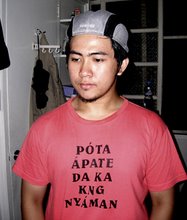Kapampangans at the Taboan Philippine Int’l Writers Festival
By Jason Paul Laxamana
Urban Kamaru
Central Luzon Daily
Last February 11 to 13, literary writers from different provinces gathered in Quezon City to attend the first ever Taboan Philippine International Writers Festival. The gathering is the offering of the Committee on Literary Arts of the NCCA (National Commission on Culture and the Arts), which for the first time celebrated a non-Manilacentric National Arts Month.
‘Taboan’ is a Visayan word meaning assembly, marketplace, meeting place, or rendezvous. In the Kapampangan language, the closest translation is ‘tabnuan’ or ‘sasmuan.’

True to the title’s meaning, the festival gathered both young and old writers from the regions to attend various discussions on topics ranging from writing for a living, literature and publishing in the provinces, new forms of publishing, children’s literature, language and literature, building literary careers, emerging genres of fiction, to transforming literature to stage and screen plays, the non-reading youth, experimental poetry, feminism in literature, and writing for an international audience.
Delegates from the province were Kragi Garcia, representing the older generation, and yours truly, the younger generation, both accompanied by UP Pampanga Directress Prof. Juliet Mallari, who happens to be part of NCCA’s Literary Arts Committee.

Decentralizing Pinoy lit
Like Philippine Cinema, Philippine Literature has often been Manila/Tagalog-centric. The ongoing history of national literature has always put the spotlight on the writers from the center, not taking into account the developing—or perhaps, even the long-existing—literary scenes from the regions.
In my elementary and high school years, all the literary works we were required to read for our Filipino class were Tagalog pieces, rendering me ignorant of works from other provinces and even of Kapampangan literature. Only during my self-imposed literary journey have I been exposed to the works of Jose Gallardo, Juan Crisostomo Soto, and other Kapampangan luminaries.
English and Tagalog literature have for a long time occupied for themselves the box called Philippine or National Literature, that is why non-Tagalog and non-English works settled for their respective regional titles—Cebuano Literature, Waray Literature, Kapampangan Literature, Ilonggo Literature, etc.
If logic be applied, then it means Cebuano Literature is Cebuano Literature, not Philippine Literature, same way as having to coin the term Bisrock for Bisaya Rock, when there’s already Pinoy Rock. This is because Philippine Literature has always been associated with Tagalog and English.
With the organization of Taboan, however, this might begin to change eventually. Any Filipino work, regardless whether it is in Ilokano, Kankanaey, or Maranao, will be called Philippine Literature. If the language be needed to be emphasized, we’ll call a Kapampangan work “Philippine Literature in Kapampangan.”
The undocumented present
By listening to the stories of other people about their respective regions’ contemporary literature, I’ve realized that the Kapampangan literary scene is more endangered than I thought.
It’s not about the dispute over orthography—although this is still a problem. It’s probably not even about the illiteracy of young Kapampangans in their native language. For me, it’s the scarcity of this generation’s authentic storytellers—using whatever medium—that poses the biggest problem.
I was in the Angeles University Foundation last week delivering a lecture about contemporary Kapampangan culture to Communication students. I asked the audience if there were writers among them. No one was raising a hand—not until I complained about the pekat-pekat attitude of my fellow youth, which I said was a disgrace to our mighty ancestors.
So one girl raised her hand and I asked her what she writes. Fictional prose and poetry, she said. Then I asked her to recite the synopsis of her favorite among her own works. She told me the story of a Mindanao-residing boy affected by the war in the Middle East and in Mindanao—or something like that.
Then I asked her if she has ever written anything with a Kapampangan as a main character. She shook her head. “How about a story set in Pampanga?” I received the same answer. It didn’t surprise me though.
Of course she’s just one girl, and I know that to conclude based on the account of one person is illogical—but really, I have been encountering this case as if it’s the norm—a scary one—for the Kapampangan youth, even the supposedly bright ones. Aside from refusing to use their native language in literary writing, they write about stuff happening either nowhere or elsewhere, anywhere but never their homeland.
If one is to get a feel of the Kapampangan region through literature, the present decade and probably the 90s would be murky “mirrors of society.” Or probably, they would be “mirrors of society in the eyes of the elders.” The perspective of the young storyteller has gone missing.
Mystery of the rappers
This might come as a surprise, but, actually, local underground rappers are probably the only consistent homeland-rooted storytellers of my generation. Their rap tracks are available only through the web or through pirated CDs in Angeles City, but if you listen to their lyrics, albeit usually not in Kapampangan, you’ll get the impression that they are writing about their immediate surroundings—something not done even by most erudite college publication writers in the province.
The topics of their rap songs of course are not the type that would win Palancas or even the Buwan ng Wika writing contests, but you can somehow detect the local storyteller within them.
The mainstream example would have to be Apl De Ap’s “Bebot” song. Apl De Ap of the Black Eyed Peas is from Sapang Bato, Angeles City, and in spite of his international fame, some of his compositions still mirror his Kapampangan life. Take for example an excerpt from “The Apl Song.”
Listen closely yo, I got a story to tell
A version of my ghetto where life felt for real
Some would call it hell but to me it was heaven
God gave me the grace, amazin' ways of living
How would you feel if you had to catch your meal?
Build a hut to live and to eat and chill in.
Having to pump the water outta the ground
The way we put it down utilizing what is around
Like land for farming, river for fishing
Everyone helpin' each other whenever they can
We makin' it happen, from nothin' to somethin'
That's how we be survivin' back in my homeland
How to solve
I don’t have the antidote to this dilemma, but I can share my thoughts. First of all, schools play an important role in making students aware of the culture, history, and literature of the Kapampangans. I think if our young storytellers were exposed more to homeland-rooted literary works, they would be somehow swayed to that direction.
Being chained to the past would most likely be the next problem. If these storytellers only read works that speak of life in the peaceful meadows, Japanese period struggles, and other pieces where all female characters are Maria Claras, they might end up writing about the past, the way they imagine it, instead of writing about their own time.
We are a unique generation compared to our predecessors. We are the MTV generation, the DIY generation, the anime generation, the digital generation, the global village generation, and many other things, such that only we can probably write about directly from the heart. We are a generation addicted to social networking simultaneously having Friendster, Multiply, Facebook, MySpace, YouTube, and probably even Xtube accounts, while keeping diverse contacts in our phone books—and to not include these things, along with other “strange” concepts that cause our fights with our parents, in our generation’s literature will be a great denial of reality. Literature then fails.
Also, perhaps we should promote Creative Writing more in our province. I wonder why we don’t have annual writing workshops like those of Cebu, Negros, and Baguio. And how come we don’t have a Kapampangan category for the Palanca Awards? Or better yet, why don’t we have local literary contests, aside from the oral poetry (pamigale) contests where elders dominate?
Creative Writing has always been limited to the school publications, making it seem as though it’s the grandest thing a young Kapampangan literary writer can achieve locally—to be published in the school paper.
Send reactions to sisig_man@yahoo.com.ph








1 comment:
^_^
- dexter
Post a Comment